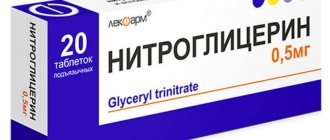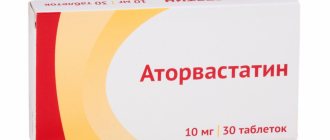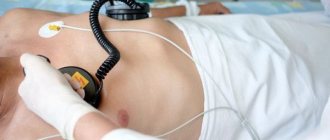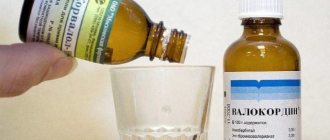Overdose
Symptoms: weak or rapid heartbeat, increased body temperature, cyanosis of the lips, nails or palms, convulsions, dizziness, fainting, shortness of breath, a feeling of strong pressure in the throat, weakness.
Treatment: transfer the patient to a position with legs raised (to enhance venous return); for hypotension - intravenous administration of alpha-adrenergic receptor agonists (with the exception of epinephrine), for methemoglobinemia - administration of methylene blue (iv) and oxygen therapy, for headache - taking aspirin or drugs containing menthol.
Nitrospray sublingual dose. 0.4 mg/dose 200 doses 10 ml
Registration Certificate Holder
PHARMSTANDARD-LEKSREDSTVA (Russia)
Dosage form
Medicine - Nitrospray
Description
Sublingual dosed spray
in the form of a clear, colorless liquid.
1 dose
nitroglycerin (as a 4% solution) 400 mcg
Excipients
: ethanol (rectified ethyl alcohol).
10 ml (200 doses) - polypropylene bottles (1) with a mechanical dosing pump complete with a spray nozzle - cardboard packs.
Indications
- relief and prevention of angina attacks.
Contraindications for use
- shock;
- vascular collapse;
- acute myocardial infarction with hypotension;
- arterial hypotension (systolic blood pressure below 90 mmHg);
- hemorrhagic stroke;
- recent head injury;
- constrictive pericarditis;
- closed-angle form of glaucoma;
- hypertrophic cardiomyopathy;
- toxic pulmonary edema;
- pregnancy;
- lactation period (breastfeeding);
- childhood;
- hypersensitivity to nitroglycerin and other organic nitrates.
pharmachologic effect
Peripheral vasodilator with a predominant effect on venous vessels, antianginal drug.
The effects of nitroglycerin are due to the ability to release nitric oxide from its molecule, which is a natural endothelial relaxing factor. Nitric oxide increases the intracellular concentration of cyclic guanosine monophosphatase, which prevents the penetration of calcium ions into smooth muscle cells and causes them to relax. Relaxation of the smooth muscles of the vascular wall causes vasodilation, which reduces venous return to the heart (preload) and resistance of the systemic circulation (afterload). This reduces the work of the heart and the myocardium's need for oxygen. Dilatation of coronary vessels improves coronary blood flow and promotes its redistribution to areas with reduced blood supply, which increases oxygen delivery to the myocardium. A decrease in venous return leads to a decrease in filling pressure, improved blood supply to the subendocardial layers, a decrease in pressure in the pulmonary circulation and regression of symptoms of pulmonary edema. Nitroglycerin has a central inhibitory effect on the sympathetic tone of blood vessels, inhibiting the vascular component of the formation of pain. Nitroglycerin also relaxes the smooth muscle cells of the bronchi, urinary tract, gallbladder, bile ducts, esophagus, small and large intestines, as well as their sphincters.
Drug interactions
Other antihypertensive drugs, antidepressants, PDE inhibitors (sildenafil), ethanol may enhance the hypotensive effect of Nitrospray. In this case, the effectiveness of Nitrospray may decrease.
When used simultaneously with Nitrospray, the anticoagulant effect of heparin may be reduced.
Dosage regimen
The drug is used sublingually. Each press of the dosing pump releases 1 dose (400 mcg of nitroglycerin) as an aerosol.
To relieve an attack of angina
at the first signs of it, 400-800 mcg (1-2 doses) are applied to or under the tongue while holding your breath. The interval between repeated doses should be at least 30 seconds. If necessary, the drug is re-administered at 5-minute intervals, but not more than 3 doses within 15 minutes.
To prevent the development of an attack
administer 400 mcg (1 dose) 5-10 minutes before the expected load or stress.
The maximum single dose is 1.6 g (4 doses), the maximum daily dose is 6.4 g (16 doses).
Before first use or after a long break in use, it is recommended to fill the aerosol chamber by pressing the dispensing valve several times until the aerosol appears. The packaging should not be shaken before use; when spraying, it should be held vertically, directly in front of you. After each spray of the aerosol, you should close your mouth; it is recommended not to swallow immediately.
Overdose
Symptoms:
cyanosis of the lips, nails, palms, dizziness, fainting, feeling of strong pressure in the head, shortness of breath, unusual fatigue or weakness, weak and rapid heartbeat, elevated body temperature, convulsions.
Treatment:
transferring the patient to a lying position with elevated legs, conducting symptomatic and supportive therapy.
Side effect
From the side of the central nervous system:
blurred vision, headache (especially at the beginning of treatment, decreases with continued therapy), dizziness, weakness, restlessness.
From the cardiovascular system:
arterial hypotension (including orthostatic), reflex tachycardia, facial hyperemia;
rarely (with a sharp decrease in blood pressure) – increased symptoms of angina pectoris (paradoxical “nitrate” reactions). From the digestive system:
dry mouth, nausea, vomiting.
Dermatological reactions:
dermatitis, skin rash.
special instructions
Due to the increased risk of developing orthostatic reactions during the period of use of the drug, caution should be exercised when abruptly moving to a standing position from a lying or sitting position, during prolonged standing, when performing physical exercises, or in hot weather.
Discontinuation of the drug should be done gradually and under the supervision of a physician.
During the period of use of the drug, you should avoid drinking alcohol.
Storage conditions
List B. The drug should be stored in a place protected from light and out of reach of children at temperatures up to 30°C, away from open flame.
Best before date
Shelf life – 3 years.
Use during pregnancy and breastfeeding
Restrictions during pregnancy - Contraindicated. Restrictions when breastfeeding - Contraindicated.
The drug is contraindicated for use during pregnancy and lactation.
Use in children
Restrictions for children - Contraindicated.
Contraindicated: children's age.
Terms of sale
The drug is approved for use as a means of OTC.
Contacts for inquiries
PHARMSTANDARD JSC (Russia)
141701 Moscow region. Dolgoprudny, Likhachevsky pr-d, 5B Tel./fax E-mail
Precautionary measures
If after taking 3 doses within 15 minutes there is no relief of the attack, a doctor’s consultation or hospitalization of the patient is necessary. You should refrain from using the drug in pediatric practice, since the safety and effectiveness of its use in children have not been determined. Alcohol consumption should be avoided during therapy. To reduce headaches, simultaneous administration of acetylsalicylic acid or menthol-containing drugs is possible. The drug should be discontinued gradually.
Buy Nitrospray FST sublingual spray 04.mg/dose 200doses 10ml in pharmacies
Trade name of the drug:
Nitrospray
International nonproprietary or generic name:
nitroglycerine
Dosage form:
dosed sublingual spray
Compound:
Nitroglycerin solution 4% - 250 g (in terms of nitroglycerin) - 10 g Ethanol - up to 1000 g (rectified ethyl alcohol)
Description:
a clear, colorless liquid contained in a bottle with a mechanical dosing pump. The determination is carried out immediately after opening the bottle.
Pharmacotherapeutic group:
vasodilator - nitrate
Pharmacological properties
Nitroglycerin is an organic nitrogen-containing compound with a predominant venodilating effect.
Mechanism of action
The effects of nitroglycerin are due to its ability to release nitric oxide from its molecule, which is a natural endothelial relaxing factor.
Nitric oxide increases the intracellular concentration of cyclic guanosine monophosphatase, which prevents the penetration of calcium ions into smooth muscle cells and causes them to relax. Relaxation of the smooth muscles of the vascular wall causes vasodilation, which reduces venous return to the heart (preload) and resistance of the systemic circulation (afterload). This reduces the work of the heart and the myocardium's need for oxygen. Dilatation of coronary vessels improves coronary blood flow and promotes its redistribution to areas with reduced blood circulation, which increases oxygen delivery to the myocardium.
A decrease in venous return leads to a decrease in filling pressure, improved blood supply to the subendocardial layers, a decrease in pressure in the pulmonary circulation and regression of symptoms of pulmonary edema. Nitroglycerin has a central inhibitory effect on the sympathetic tone of blood vessels, inhibiting the vascular component of the formation of pain. Nitroglycerin relaxes the smooth muscle cells of the bronchi, urinary tract, gallbladder, bile ducts, esophagus, small and large intestines. The action begins quickly, the effect develops within 1-1.5 minutes and lasts approximately 30 minutes.
Pharmacokinetics
Nitroglycerin, when administered sublingually, is quickly and completely absorbed from the oral cavity into the systemic circulation. Bioavailability is 100% when taken sublingually, since “primary” hepatic degradation of the drug is excluded. The maximum concentration in blood plasma is reached after 4 minutes. The connection with blood plasma proteins is 60%. It is quickly metabolized with the participation of nitrate reductase, with the formation of di- and mononitrates (only isosorbide-5-mononitrate is active), the final metabolite is glycerol. Excreted by the kidneys in the form of metabolites. The total clearance is 25-30 l/min. After taking the drug sublingually, the half-life from blood plasma is 2.5-4.4 minutes. Circulating nitroglycerin is tightly bound to red blood cells and accumulates in the walls of blood vessels. The main route of elimination of nitroglycerin is the extraction of metabolites in the urine; less than 1% of the dose is excreted unchanged.
Indications for use
- prevention of angina attacks through prophylactic use of the drug before physical activity; - relief of angina attacks; - acute left ventricular failure (including acute myocardial infarction).
Contraindications
- increased sensitivity to organic nitrates; — closed-angle form of glaucoma; - severe arterial hypotension; - increased intracranial pressure caused by cerebral hemorrhage or trauma; - simultaneous use of phosphodiesterase inhibitors; - age under 18 years (lack of sufficient clinical data).
Carefully:
acute myocardial infarction with low left ventricular filling pressure (risk of decreased blood pressure and tachycardia, which can increase ischemia), chronic heart failure with low left ventricular filling pressure, severe anemia, thyrotoxicosis, hypertrophic cardiomyopathy (possible increased frequency of angina attacks), severe renal failure, liver failure (risk of developing methemoglobinemia).
Pregnancy and lactation
There is no data on the penetration of nitroglycerin into breast milk.
Use during pregnancy and breastfeeding requires careful comparison of risks and benefits and should be carried out under strict medical supervision.
Directions for use and doses
It is recommended to take the drug as prescribed by a doctor to avoid complications.
Relieving an attack of angina
At the first attack of angina, use 1 or 2 doses sublingually. If necessary, can be reapplied at 5-minute intervals. If after taking three doses within 15 minutes the attack does not stop, you should immediately consult a doctor.
For preventive purposes, use 1 dose 5-10 minutes before the expected load or stress.
Highest single dose: 4 doses. Highest daily dose: 16 doses.
Rules for taking the drug:
- if possible, sit down - remove the protective cap from the balloon, hold the balloon vertically - open your mouth and hold your breath for a few seconds - press the balloon once, directing the stream of the drug under the tongue - close your mouth and try not to swallow the drug.
When using for the first time or after long-term non-use, it is recommended to release one dose into the air to fill the aerosol chamber before direct use.
Side effect
From the cardiovascular system: dizziness, headache, tachycardia, fever, decreased blood pressure; rarely (especially in case of overdose) - orthostatic collapse, cyanosis.
From the digestive system: dry mouth, rarely - nausea, vomiting, abdominal pain.
From the central nervous system: weakness, rarely - anxiety, psychotic reactions, lethargy, disorientation.
Allergic reactions: rarely - skin rash, itching.
Local reactions: skin hyperemia, burning sensation under the tongue.
Other: rarely - blurred vision, hypothermia, methemoglobinemia.
Overdose
Symptoms: headache, decreased blood pressure, orthostatic hypotension, reflex tachycardia, dizziness, facial flushing, vomiting and diarrhea, asthenia, increased drowsiness, feeling hot. Extremely high doses (more than 20 mg/kg) lead to methemoglobinemia, cyanosis, dyspnea and tachypnea, and orthostatic collapse.
Treatment: in mild cases, transfer the patient to a lying position with legs elevated.
In case of severe manifestations of overdose, general methods of treating intoxication and shock (replenishment of circulating blood volume, norepinephrine, and/or dopamine, etc.) should be used.
The use of epinephrine (adrenaline) is contraindicated.
When methemoglobinemia develops, the following antidotes and treatment methods can be used:
1. Vitamin C - 1 g in the form of sodium salt or intravenously. 2. Methylene blue intravenously in a dose of up to 50 ml of a 1% solution. 3. Toluidine blue intravenously, the first dose is 2-4 mg/kg, then repeatedly 2 mg/kg. 4. Oxygen therapy, hemodialysis, blood transfusion (exchange).
Interaction with other drugs
Other vasodilators and antihypertensive drugs (beta-blockers, slow calcium channel blockers), angiotensin-converting enzyme (ACE) inhibitors, antipsychotics, tricyclic antidepressants, monoamine oxidase inhibitors (MAO), procainamide and ethanol may enhance the hypotensive effect of nitroglycerin.
Nitroglycerin enhances the effect of dihydroergotamine and reduces the effectiveness of heparin.
Orthostatic collapse may occur against the background of quinidine and procainamide.
Concomitant use with phosphodiesterase type 5 (PDE 5) inhibitors - sildenafil, tadalafil, vardenafil - may enhance the drug's ability to lower blood pressure.
special instructions
Nitroglycerin enhances the excretion of catecholamines and vanillinmandelic acid in the urine.
The consumption of alcoholic beverages while using the drug is strictly prohibited.
Impact on driving and work requiring increased attention
At the beginning of treatment, it is necessary to refrain from driving vehicles and engaging in potentially hazardous activities that require increased concentration and speed of psychomotor reactions. In the future, the degree of restrictions is determined individually for each patient.
Release form
Sublingual spray dosed 0.4 mg/dose.
10 ml (200 doses) in polypropylene bottles equipped with mechanical dosing pumps, nozzles and protective caps.
The bottle along with instructions for use is placed in a cardboard pack.
Storage conditions
List B. In a dark place, away from fire, at a temperature not exceeding 30 °C.
Keep out of the reach of children.
Best before date
3 years. Do not use after the expiration date indicated on the package.
Conditions for dispensing from pharmacies
Over the counter.






